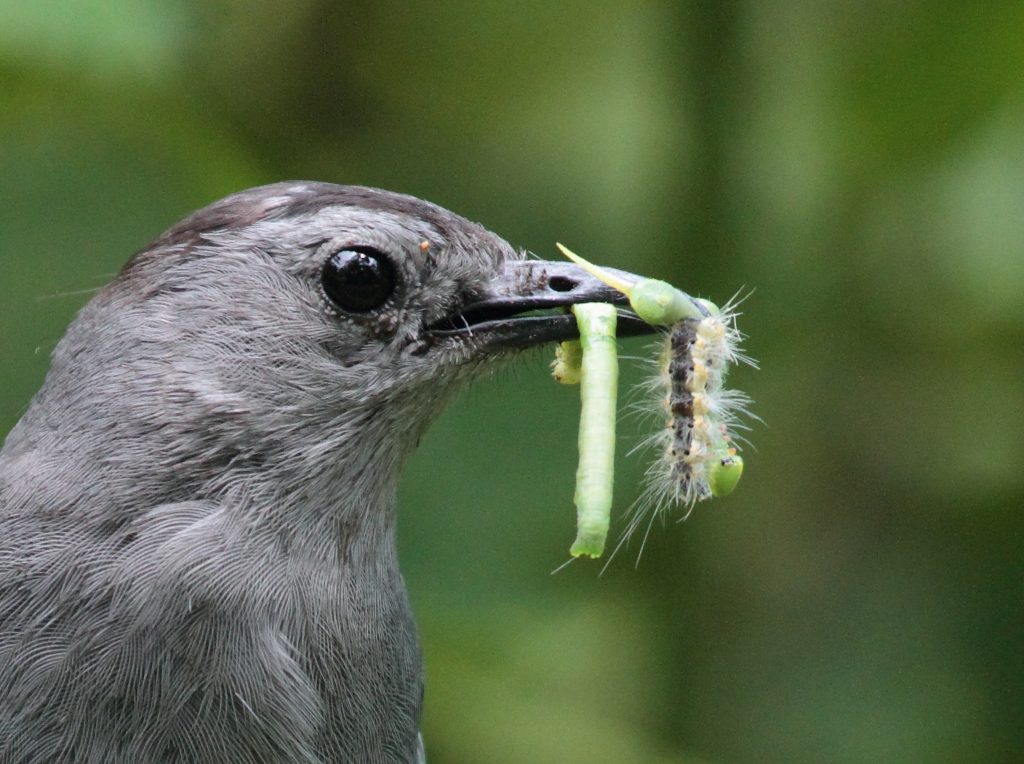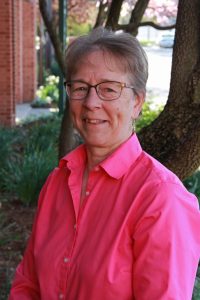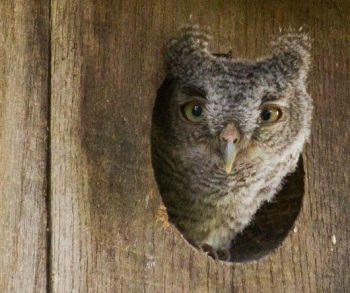By Eric Wallace

Gray Catbird with Caterpillars CO Diane Lepkowski
Diane Lepkowski was hesitant to join a bird club—yet doing so introduced her to a life changing passion. Atlasing for the VABBA2 has brought further opportunities and rewards to her birding journey.
It’s the spring of 2008 and Harrisonburg Deputy Zoning Administrator/ Deputy Subdivision Agent Diane Lepkowski is enjoying a 1.6-mile hike at Lake Shenandoah. Located near Massanutten Mountain, and managed by the Virginia Department of Wildlife Resources, the 36-acre impoundment is a favorite among local birders. Despite neighborhoods to the west, its eastern shores are lined with forests—which are themselves backed by farmland and fields. The ecological medley enables visitors to glimpse a diverse range of species like Double-crested Cormorant, Pied-billed Grebe, Green Heron, Ruby-crowned Kinglet, American Goldfinch, and more.
“Back then, though, I was more of a hiker,” says Lepkowski, 62. “I loved being outside and seeing birds, but I wouldn’t have been able to tell you any of those names. I could identify the ones that came to my feeder, but that was about it.”
Lepkowski was eying a cluster of distant waterfowl when she came upon Greg Moyers gazing through a pair of binoculars. A veteran of the Rockingham Bird Club, he cheerfully invited her to have a look.
“We started talking and he told me all about the different birds I was seeing and how to identify them,” says Lepkowski. The conversation was interrupted by a hellish avian shriek and crashing brush. The noise stopped as abruptly as it began. Investigating a nearby shrub, they discovered a Coopers Hawk. Its talons held a bloodied Mockingbird. “I’d never seen anything like that,” says Lepkowski. “It was pretty incredible—sad and awe-inspiring at the same time.”
Moyer took the opportunity to explain accipiter characteristics and hunting methods. Noting Lepkowski’s intrigue, he encouraged her to attend a club meeting. But she was hesitant.

Diane Lepkowski
“I realized I harbored a terrible stereotype about birders,” Lepkowski says with a laugh. “Though I’m embarrassed to admit it, in my head, I saw this picture of little old ladies sitting on benches wearing spectacles and white tennis shoes.”
Of course, Moyer didn’t fit the bill. Lepkowski decided to give it a try.
What she found was a robust nature-based community ranging from kids, to 20- and 30-somethings, to middle-agers, to active octogenarians. The group included college professors, lawyers, teachers, farmers, government workers, homesteaders—in short, people from all walks of life. Trekking 5-plus-miles into remote areas to search for rarefied birds was par for the course. Better still, they were passionate about helping newbies.
“Everyone was so great and supportive, it was kind of like joining a second family,” says Lepkowski. Birding added depth and focus to her outdoor adventures. Learning to look for groups like warblers opened new worlds of experience and introduced fascinating local habitats. “I got obsessed,” she says. “I bought books. I started birding before work; making stops on the way home; taking trips on weekends. It just totally rewired my life.”
By 2009, Lepkowski had become one of the club’s most active members. She was elected Vice President of Fieldtrips a year later—and has held the post ever since. Joining the Virginia Society of Ornithology, she coordinated outings for annual meetings in both 2011 and 2018.
“To me, group trips are the best part, because that’s where the action happens!” says Lepkowski with a laugh. Given her active lifestyle and knack for administrative leadership, “it felt natural for me to take on that role.” As time went on, she found joy in introducing rookie birders to the lifestyle.
Lepkowski viewed the second Virginia Breeding Bird Atlas as an opportunity for further enrichment. Atlasing would add layers to her birding experience.

“With atlasing, you’re not just going out looking for cool birds and completing lists,” she says. Identifying breeding activity requires learning how species interact with their environment. “You’re watching behavior and trying to figure out what birds are doing. It takes a bit more patience and effort, but there’s an inbuilt reward: Species you’ve seen a million times take on a new and interesting light.”
Lepkowski cites a pair of Blue Jays as an example. Spotting the duo flitting in and out of a tree in her front yard, she crept outside for a closer look. Scoping the branches, she espied three twigs laying across the crotch of some small limbs. The jays obsessed over their placement.
“They’d move one, look at it a while, then move it again,” says Lepkowski. The show went on for 10-15 minutes. More than entertaining, she bet the pantomime marked the beginnings of a nest. A few days later, she checked again. “It had gone from three little sticks to a bona fide nest, almost overnight,” she says. Just then, the male swooped in holding a 2-foot piece of plastic chording. “He handed it off to the female and away he went. She spent an hour weaving it into the nest, and it stayed there throughout the season.”
With a demanding job, Lepkowski’s ability to Atlas in the field is limited. But that hasn’t stopped her from participating.
“With the support and guidance of her local Atlas regional coordinator, Lisa Koerner-Perry, Diane has used her position in the club to increase awareness, organize Atlas-themed fieldtrips, and help promote block-busting efforts in remote locations throughout Rockingham and surrounding counties,” says project director Ashley Peele, Ph.D. “Her work has been crucial and effective. Furthermore, she’s shown us that, though you may not be able to collect a high volume of data, you can make valuable contributions by advocating for the project in your own birding community.”
Lepkowski says she’s happy to help.
With Atlases conducted at intervals of 25-30 years, “for many of us, this is a once-in-a-lifetime opportunity,” she says. “We won’t get another chance to contribute to a project of this magnitude and importance. There’s so much ground to cover and the scientists can’t do it all by themselves. As citizen-birders, we need to step up. Because this project is about more than just birds—it’s about protecting and preserving the nature that we so love and cherish for future generations.”
Are you a birder living in or around Rockingham County? Are you interested in paying a visit? The Rockingham Bird Club would love to have you sit in on a fieldtrip. The group will be hosting Atlas-themed trips to under-birded areas throughout 2019. Make new friends, discover cool birds, and explore some of the area’s best habitats alongside knowledgeable veterans. For upcoming dates and best contacts, check out the RBC Newsletter.


